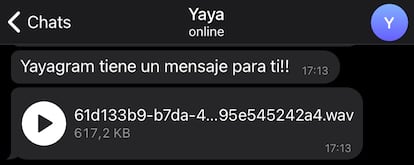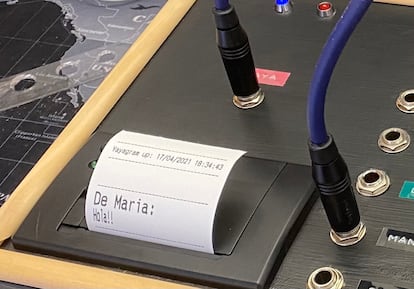The Spanish engineer who created the ‘Yayagram’ to communicate with his granny
The computer expert devised a system to let his 96-year-old grandmother, who has trouble using the phone, stay in touch with her grandchildren despite the coronavirus confinements


Some great entrepreneurs got their start in a garage. And then there is Manuel Lucio, a Spanish computer engineer who came up with a nifty invention because his grandma had trouble using the phone.
A resident of Burgos who suffers from arthritis, Felisa Romano, 96, was finding it increasingly difficult to talk to her grandchildren on the phone or via video conference. Her family is scattered between Burgos, Oviedo, Bilbao and Madrid, and many relatives cannot go see her in person because of coronavirus-related restrictions on movement.
So Lucio put on his thinking cap and came up with a solution that has earned him thousands of Twitter followers. Now, thanks to his ‘Yayagram’ – which plays on the Spanish informal term for grandma, yaya – the family matriarch can send and receive messages all by herself.

Lucio, 35, defines his device as a “contraption” and avoids using any fancy words to talk about “a box that allows communication via voice messages.” The box has a button that Felisa presses to start recording her voice, and then, just as telephone operators used to do, she selects who she wants to contact. Her message is then sent as a normal audio, and reaches the Telegram messaging app that her family members have downloaded.
The app tells them, “Yayagram has a message for you!” and they can then listen to their grandmother. When Felisa receives their reply, she can read it in enlarged print thanks to a small thermal printer “like the ones in supermarkets,” which is connected to the Yayagram.
Lucio explains that his grandmother doesn’t quite understand how the contraption works but is “delighted” all the same. The machine uses a WiFi internet connection and is plugged into an electrical outlet just like any household appliance. It also has handles so that its owner can carry it around if she needs to.
The engineer laughs when he recalls the first test he did with his grandmother, which involved telling her they were having artichokes and ham for dinner. “We had a proper, flowing conversation that was impossible before,” he says.

While Felisa’s arthritis prevents her from using screens and telephones, hearing problems make it uncomfortable for her to chat on a cellphone. Lucio’s solution might have come at a price regarding brainpower, but in terms of euros, it was cheap. The printer cost around €30, the cables and connectors, €10, the microphone was €6 and the Raspberry Pi – a micro computer that organizes the whole procedure – set him back another €30. Lucio says he likes to use local shops for components, thereby ensuring the quality is decent and also completing the cycle of local entrepreneurship for those who enjoy “tinkering” in their spare time.
The computing aspect of the Grannygram is executed through a program that Lucio has created himself combined with the existence of programming languages in Telegram, collected in a virtual library on the Python platform.
We had a proper, flowing conversation that was impossible beforeManuel Lucio, Spanish engineer
The whole experience has made him more aware of the digital generational gap; while Felisa finds it strange to press a button to record and send an audio message, younger generations take these procedures in their stride.
But everything has a cost-effective solution: Lucio is thinking of replacing the button that connects to the microphone with a traditional phone, because Felisa is in the habit of picking up a handset and talking into the mouthpiece.
Regarding his wider audience, Lucio is astounded by the impact his device has had on social networks. In response to his Twitter thread, he has received more than 40,000 messages relating to the development of his invention.
“I’m overwhelmed,” he says, adding that he’ll need time to respond to all the requests he has received on how to rig up the system. He doesn’t want to brush anyone off, particularly as he made it clear that anyone could get in touch for advice. He is also wondering how best to showcase his invention and is considering a “more advanced” tutorial for those with grandparents in need of custom-made technology.
And while he has considered patenting the Yayagram, Lucio says it’s not something that keeps him awake at night: “I’d rather see people making one for their own grandparents.”
English version by Heather Galloway.
Tu suscripción se está usando en otro dispositivo
¿Quieres añadir otro usuario a tu suscripción?
Si continúas leyendo en este dispositivo, no se podrá leer en el otro.
FlechaTu suscripción se está usando en otro dispositivo y solo puedes acceder a EL PAÍS desde un dispositivo a la vez.
Si quieres compartir tu cuenta, cambia tu suscripción a la modalidad Premium, así podrás añadir otro usuario. Cada uno accederá con su propia cuenta de email, lo que os permitirá personalizar vuestra experiencia en EL PAÍS.
¿Tienes una suscripción de empresa? Accede aquí para contratar más cuentas.
En el caso de no saber quién está usando tu cuenta, te recomendamos cambiar tu contraseña aquí.
Si decides continuar compartiendo tu cuenta, este mensaje se mostrará en tu dispositivo y en el de la otra persona que está usando tu cuenta de forma indefinida, afectando a tu experiencia de lectura. Puedes consultar aquí los términos y condiciones de la suscripción digital.
More information
Últimas noticias
Pinochet’s victims grapple with José Antonio Kast’s rise in Chile
Reinhard Genzel, Nobel laureate in physics: ‘One-minute videos will never give you the truth’
From digital curfews to blocking apps: How technology experts protect their children online
Why the price of coffee has skyrocketed: from Brazilian plantations to specialty coffee houses
Most viewed
- Why we lost the habit of sleeping in two segments and how that changed our sense of time
- Pablo Escobar’s hippos: A serious environmental problem, 40 years on
- Trump’s obsession with putting his name on everything is unprecedented in the United States
- The Florida Keys tourist paradise is besieged by immigration agents: ‘We’ve never seen anything like this’
- Charles Dubouloz, mountaineering star, retires at 36 with a farewell tour inspired by Walter Bonatti









































